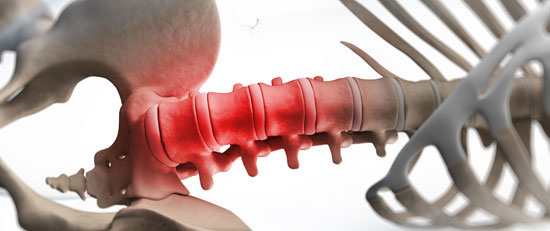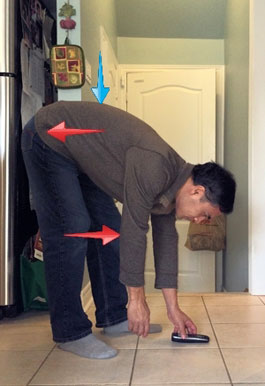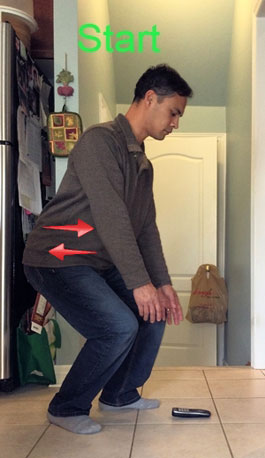The #1 Tip to Prevent Back Pain
By Sherwin Nicholson | May 4, 2020

There is something wrong that we ALL do but shouldn’t
We bend down the wrong way.
Incorrect bending leads to disc injury
We rarely do it in a safe and balanced way. Not only is there unbalanced pressure on your discs when you lean over, but also when raising up and it’s harmful.
An unnatural curve in your spine is also more likely to occur when you do this.
Take a look at the first image below. You can see a slight curve in my lower back when I am reaching downward. Observe in the picture where my elbows and hips are relative to one another (red arrows).
Most of us do not experience pain with this method because there is enough disc height and cushioning in between each vertebra. Lifting relatively light objects aren’t usually risky.
However, if you find yourself constantly doing this, you’re creating unbalanced disc pressure, wear and degeneration. Your hip muscles will no longer remain active, and a poor pelvic tilt will cause a disc bulge. Lifting anything at this time just makes it all worse.
The Wrong Way

The most harm to the back is happening at this moment
Over time, this becomes progressively risky for your spine.
The Right Way
There is a better way to protect yourself easily. It retrains you and reconditions the muscles responsible for protecting your spine. With time, this will be a natural movement.
When you need to lean over, whether to reach for something or to pick it up, follow this One Simple Rule:
Keep Your Elbows Above Your Hips. That’s it.
Now this time, take a look at my posture below. You can see that both my hip AND leg muscles are engaged. There is no bend encouraged in the spine.
The lower back muscles are recruited and activated along with the glute muscles. At NO time is it necessary for the level of my elbows to be below that of my hips.
The arrow at the top is pointing at the elbow, while the arrow at the bottom is pointing and the hip bone.
The weight of the upper body still remains above the pelvis which reduces the chance of a disc bulge that can herniate or trigger a spasm. Notice how the upper body has only leant over at a fraction of the angle of the first image. I can still maintain a neutral curve, which is key.
Keeping your leg muscles engaged in this movement prevents injury.

Your back is stable, active and protected here

Both your legs and hips are protecting your back now
This is a much safer and preferred alternative to leaning over. If you keep yourself aware of this rule, then you force yourself to consciously bend at the hips, the knees and not the back.
Look at the benefits:
- both your leg and hip muscles are activated and moving.
- there is much less effort and strain on your body and spine
- you will reduce your chances of spasm and injury dramatically
- lifting this way becomes very easy to do.
If you have difficulty performing this simple rule, you most likely have back issues. But you shouldn’t avoid it.
Avoiding this method can make you more prone to both acute and chronic lower back pain. If you would like to pursue further help for this problem, this website provides a wealth of information and support to treat your pain.
To protect yourself from injury, keep aware of maintaining the following:
- Minimal bending, twisting and arching of the spine
- Keeping your pelvis neutral and stable
- Engaging your leg muscles, specifically your gluteal muscles
- Lowering your hips as you bend
Point 4 is often the least performed but is very important.
Most people will bend their back while lowering their upper body down to a lower level. Although doing this can seem very practical and may not hurt you, it is very risky.
Moving this way can easily cause you to develop back spasms. If done repeatedly, without balance, control and with excess weight, you’ll risk chronically suffering.
Do you need more help? Follow these tough tips for your pain.
If you are hurting, download and start the eBook. It will help you with many other areas that contribute to your pain.
“ I really liked this eBook as I have a lot of issues with my back after a wreck and this had a lot of helpful information that I needed to know.”
References:
- Core Training Anatomy – Dr. Abigail Ellsworth. Baker & Taylor Publishing Group, 2010.
- www.nih.gov (The National Institutes of Health)
- Early Management of Persistent Non-specific LBP. NICE Clinical Guidelines, No. 88 http://www.ncbi.nlm.nih.gov/pubmedhealth/PMH0005442/
- Core Stability Exercise Versus General Exercise for Chronic LBP. – Coulombe BJ1, Games KE2, Neil ER2, Eberman LE2. J Athl Train. 2017 Jan;52(1):71-72. doi: 10.4085/1062-6050-51.11.16. Epub 2016 Nov 16.
